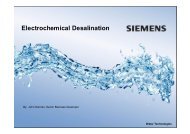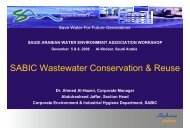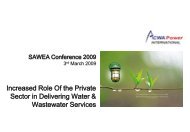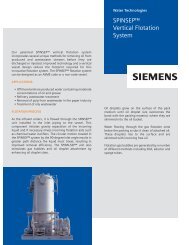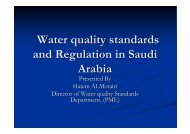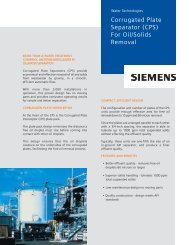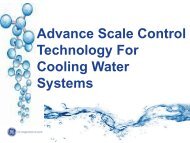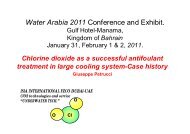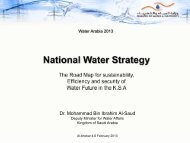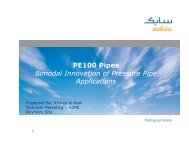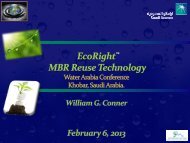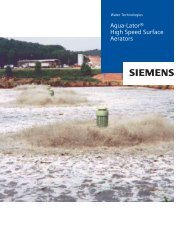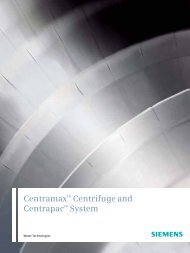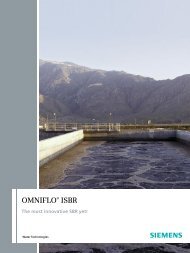You also want an ePaper? Increase the reach of your titles
YUMPU automatically turns print PDFs into web optimized ePapers that Google loves.
<strong>VLR</strong>® <strong>Systems</strong> <strong>for</strong> <strong>Biological</strong> <strong>Treatment</strong><br />
Water Technologies
Disk Aerators<br />
Coarse Bubble<br />
Diffuser Grid<br />
Horizontal Baffle<br />
Air Release System<br />
The basins of the Vertical Loop<br />
Reactor system share common walls,<br />
reducing construction costs.<br />
The Vertical Loop Reactor<br />
The Siemens <strong>VLR</strong>® system is a vertical loop reactor design based<br />
on the placement of looped reactors in series that allows DO<br />
stratification. As such, it is suited <strong>for</strong> simultaneous<br />
nitrification/denitrification, biological phosphorus removal and<br />
storm water treatment.<br />
The <strong>VLR</strong>® system is installed in a rectangular tank, and is similar<br />
to an oxidation ditch flipped on its side. There is an upper and<br />
lower compartment, separated by a horizontal baffle running<br />
the length of the tank. Commonly, three basins make up a<br />
system. The <strong>VLR</strong>® system is adapted from the proven Orbal®<br />
system and uses the same surface mounted discs to provide<br />
mixing and to deliver oxygen.<br />
The construction cost of a <strong>VLR</strong>® system is less than that of a<br />
comparable conventional oxidation ditch. Because the<br />
horizontal baffle is a structural cross beam supporting the side<br />
walls, side walls can be designed 12 inches (305 mm) thick <strong>for</strong><br />
20 feet (6.10 m) deep tanks.<br />
<strong>VLR</strong>® System Operation<br />
The typical system has two or more rectangular tanks placed<br />
side by side and operated in series. Like the Orbal® system, the<br />
first tank is used as an aerated anoxic reactor in which an<br />
oxygen deficit is maintained and the DO level kept near zero.<br />
In designs with three or more tanks in series, the aerated anoxic<br />
conditions may extend beyond the first tank. The last tank is<br />
operated with a DO level of 2 mg/l or higher.<br />
Most <strong>VLR</strong>® systems are designed <strong>for</strong> liquid depths greater than<br />
20 feet (6.10 m). The horizontal baffle is located about middepth<br />
so that both upper and lower compartments are about 10<br />
feet deep (3.05 m). The surface aeration discs establish an “over<br />
and under” mixing pattern, with the flow direction on the<br />
surface opposite the flow direction on the bottom.<br />
The surface discs are typically sufficient <strong>for</strong> mixing the entire<br />
tank. Coarse bubble diffusers in the first quadrant of the lower<br />
compartment supply any additional oxygen required by the<br />
process.<br />
The horizontal baffle prevents the coarse bubbles from<br />
immediately rising to the surface. Instead of a retention time of<br />
only a few seconds, the air bubbles must travel the full length of<br />
the tank and then be released through a special per<strong>for</strong>ated air<br />
release plate.<br />
Benefits<br />
Common wall construction - lower construction<br />
cost.<br />
Small footprint - less land area required.<br />
Dual aerator design - operating flexibility.<br />
Lengthy aeration retention time - low power costs.<br />
Coarse bubble diffusers - easy to meet peak oxygen<br />
demands.<br />
DO stratification - process adaptability.<br />
2
<strong>VLR</strong>® System Operation<br />
The <strong>VLR</strong>® system provides an overall retention time of from one<br />
to two minutes. This raises the SAE of the coarse bubble<br />
diffusers to 4 lb O 2 /bhp.h (1.35 kg O 2 /kW.h), more than twice<br />
their rating in a conventional aeration tank.<br />
In effect, the one time cost <strong>for</strong> the baffle reduces the on-going<br />
power costs of the blowers. At the same time, it allows the<br />
process to deliver fine bubble efficiency with coarse bubble<br />
reliability.<br />
First introduced in 1986, there are more than 70 <strong>VLR</strong> plants in<br />
operation ranging from 0.2 mgd (.7 MLD) to 41 mgd (155<br />
MLD). Typically, however, the <strong>VLR</strong>® system is recommended <strong>for</strong><br />
flows of more than 1.0 mgd (3.8 MLD). To reduce aeration disc<br />
requirements, designs with BOD loadings above 16 lb<br />
BOD/1000 ft 3 /d (0.26 kg/m 3 /d) are suggested. The <strong>VLR</strong>® system<br />
is most economically attractive in the loading range of 20 – 40<br />
lb BOD/1000 ft 3 /d (0.32 – 0.64 kg/m 3 /d).<br />
demands are handled by turning on additional blowers and<br />
increasing the air flow rate through the coarse bubble diffusers.<br />
This system should be considered when land area is limited,<br />
when biological nutrient removal requirements are present, when<br />
stormflow rates are high and BOD loadings fluctuate widely.<br />
Existing rectangular tanks can be retrofitted to <strong>VLR</strong>® system<br />
tanks. Tanks should be at least 40 feet long (12.2 m) and 12 feet<br />
deep (3.6 m).<br />
For purposes of total nitrogen removal or <strong>for</strong> biological<br />
phosphorus removal, <strong>VLR</strong>® system tanks can be added in front<br />
of existing aeration basins and used as aerated anoxic tanks.<br />
The <strong>VLR</strong>® system is excellent <strong>for</strong> operating under anoxic<br />
conditions since it requires minimal power draw <strong>for</strong> obtaining<br />
channel velocities.<br />
<strong>VLR</strong> System Applications<br />
Plants utilizing the <strong>VLR</strong>® system have been designed <strong>for</strong><br />
stringent biological nutrient requirements. A number of <strong>VLR</strong>®<br />
plants have been designed <strong>for</strong> excessive storm water treatment,<br />
with peak flows five times the design flow.<br />
Influent<br />
Anaerobic<br />
O2<br />
Anoxic<br />
O2<br />
Aerobic<br />
Effluent<br />
Aerated Anoxic with<br />
Anaerobic Selector<br />
Nitrogen and Phosphorus<br />
Removal<br />
The <strong>VLR</strong>® system is also beneficial in industrial applications,<br />
especially when flows and loadings vary. Peak oxygen delivery<br />
demands can easily be handled without designing in a major<br />
amount of additional mechanical aeration equipment. Peak<br />
Nitrified Recycle<br />
(Predentrification)<br />
RAS<br />
WAS<br />
3
VertiCel® BNR System: The World’s Most Energy<br />
Efficient <strong>Biological</strong> Nutrient Removal System<br />
The VertiCel® System Combines Time-Tested and<br />
Innovative Designs<br />
The VertiCel® biological nutrient removal system combines<br />
mechanical aeration in the anoxic tank with diffused aeration in<br />
the aerobic zones. Process aeration efficiency is optimized with<br />
this arrangement.<br />
Proven <strong>VLR</strong>® System Technology<br />
A key element of the VertiCel® system is its use of the <strong>VLR</strong>®<br />
system, a technology that has been successful in over 70<br />
installations. Among the benefits of the <strong>VLR</strong>® system:<br />
Combines advantages of our Orbal® disc aerators<br />
with the instant turn-on of diffused air systems.<br />
Low intensity mixing capabilities of the disc aerator<br />
reduces power costs.<br />
Deep, high rate reactor with small footprint<br />
minimizes space requirements.<br />
Easily retrofits into rectangular basins.<br />
Advanced SmartBNR Process Controls<br />
The SmartBNR process control system integrates our unique<br />
knowledge of process with a PLC-based instrumentation/control<br />
package. Intelligent control functions include:<br />
Aerator control with dissolved oxygen (DO) and<br />
oxidation-reduction potential (ORP).<br />
Automatic sludge wasting control.<br />
Automatic control of stormflow operating mode.<br />
Oxygen input is varied based on signals from DO and ORP<br />
probes. This maintains the proper environment <strong>for</strong><br />
simultaneous nitrification/denitrification and enhanced<br />
biological phosphorus removal.<br />
4<br />
<br />
Built-in safeguards prevent erratic operation even in the<br />
event of instrument failure. Other optional inputs/outputs<br />
include flow and level controls. Our SmartBNR control<br />
system interfaces with any SCADA or DCS system.<br />
DualAir® Diffusers double the bubbles<br />
Our DualAir® fine bubble membrane or ceramic disc diffusers in<br />
dual saddle holders allow twice as many diffusers per foot of<br />
pipe, reducing capital and installation costs.<br />
Benefits.<br />
Effluent quality. VertiCel® systems are designed to<br />
achieve:<br />
BOD: 5 mg/l<br />
TSS: 10 mg/l<br />
NH3-N: 0.5 mg/l<br />
Total-N: 5 mg/l<br />
Total-P: 1 mg/l<br />
Easy, reliable operation. The SmartBNR Process Control<br />
System optimizes operation, minimizes power usage and frees<br />
operators from constant monitoring.<br />
VertiCel® System Description<br />
The VertiCel® System is a suspended growth activated sludge<br />
process designed to minimize energy consumption and<br />
designed to accomplish biological nutrient removal (BNR).<br />
A unique aspect of the VertiCel® System is its ability to reduce<br />
aeration energy requirements by effectively dealing with the<br />
effects of surfactants in wastewater upon the oxygen transfer<br />
efficiency of aeration devices. Fine bubble diffusers are very
efficient in clean water but surfactants reduce this efficiency by<br />
<strong>for</strong>ming a viscous film on the surface of air bubbles. Devices<br />
that rely upon turbulence to transfer oxygen to the mixed liquor<br />
like disc aerators are less efficient in clean water; however, they<br />
deal much more effectively with surfactants. When computing<br />
aeration oxygen transfer requirements, alpha (α) is a measure<br />
of how effectively a device transfers oxygen in mixed liquor as<br />
opposed to clean water. The higher the value of α <strong>for</strong> an oxygen<br />
transfer device, the less impact surfactants will have upon its<br />
oxygen transfer efficiency. Surface aeration devices such as<br />
the disc aerators used in the VertiCel® System have<br />
substantially higher α values than diffused aeration devices.<br />
The VertiCel® System uses a combination of aeration devices to<br />
take advantage of the strengths of each device. Initial aeration<br />
and mixing in the VertiCel® System is accomplished using disc<br />
aerators due to their relative insensitivity to the presence of<br />
surfactants. A unique coarse bubble aeration grid is used in<br />
combination with turning vanes to augment the disc aeration<br />
by releasing compressed air beneath the horizontal baffle in the<br />
<strong>VLR</strong>® system. By releasing air at this location, the coarse<br />
bubbles obtain maximum bubble contact time to maximize<br />
oxygen transfer efficiency. The <strong>VLR</strong>® system is designed to<br />
operate under aerated/anoxic conditions where an oxygen<br />
deficit occurs and simultaneous nitrification and denitrification<br />
can take place.<br />
Once the surfactants have been dissipated due to treatment in<br />
the <strong>VLR</strong>® system with its disc aerators and coarse bubble<br />
aeration, fine bubble aeration can be applied much more<br />
efficiently in the down stream fine bubble aeration tanks.<br />
Raw wastewater passes progressively though the <strong>VLR</strong>® system<br />
tanks (aerated/anoxic tanks) and the fine bubble aeration tanks<br />
be<strong>for</strong>e passing on to secondary clarification. Return activated<br />
sludge (RAS) is recycled back to the <strong>VLR</strong>® system tanks. <strong>VLR</strong>®<br />
system tanks and fine bubble aeration tanks are arranged to<br />
make use of common intermediate walls. Flow controls are<br />
arranged <strong>for</strong> independent operation of any single tank or<br />
operation in conjunction with an adjacent tank.<br />
Benefits<br />
Aerated/Anoxic Nitrification – The VertiCel® System's series of<br />
reactors promotes nitrification through alternate pathways at<br />
near zero dissolved oxygen levels. The aerated/anoxic<br />
nitrification concept was pioneered by Siemens and its<br />
advantages in terms of aeration power savings and biological<br />
nutrient removal will be addressed in the proposal.<br />
Lowest Energy Costs – The VertiCel® System combines<br />
mechanical aeration in the aerated/anoxic zones with diffused<br />
aeration in the aerobic zones to optimize the process aeration<br />
efficiency. VertiCel System designs consume an average of 30%<br />
less power when compared with fine bubble aeration systems.<br />
Unique Disc Aeration – The discs have highly effective mixing<br />
and aeration characteristics and provide rapid turnover of the<br />
entire tank contents while transferring oxygen very efficiently<br />
to minimize power costs.<br />
Flexibility in Aeration – Changes in oxygen demand can<br />
readily be met by varying disc rotational speed and/or air flow in<br />
the aeration tanks.<br />
Effectively Managing Peak Flows – Surge flows are managed<br />
within the VertiCel® System without solids washout. No<br />
auxiliary peak flow facilities are needed and a more economical<br />
final clarifier design can be employed.<br />
High Quality Components – Drives, bearings, and shafting are<br />
all oversized and constructed in a rugged fashion to extend the<br />
life of the equipment while reducing maintenance<br />
requirements.<br />
5
DualAir, Orbal, SmartBNR, <strong>VLR</strong>, VertiCel and <strong>VLR</strong> are trademarks<br />
of Siemens, its subsidiaries or affiliates.<br />
The in<strong>for</strong>mation provided in this brochure contains merely<br />
general descriptions or characteristics of per<strong>for</strong>mance which in<br />
actual case of use do not always apply as described or which<br />
may change as a result of further development of the products.<br />
An obligation to provide the respective characteristics shall<br />
only exist if expressly agreed in the terms of contract.<br />
Tel: +1.262.547.0141<br />
Fax: +1.262.547.4120<br />
EN-<strong>VLR</strong>dr-BR-0808<br />
Subject to change without prior notice.<br />
©2008 Siemens Water Technologies Corp.<br />
www.siemens.com/water<br />
6



